Email newsletters bring in loyal audiences. What’s your strategy to improve them?
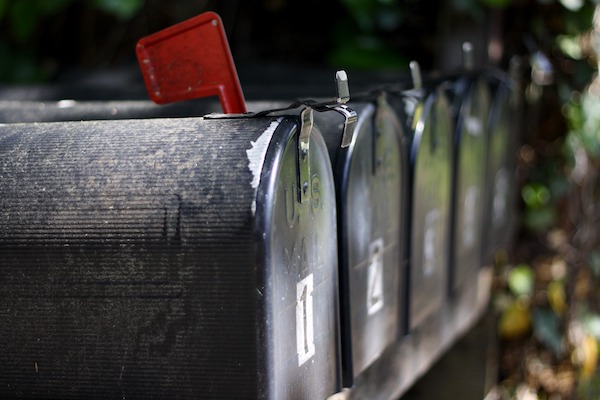
Content teams that look at data have confirmed: newsletter subscribers visit more frequently, consume for content, and convert to paying customers at a higher rate.
“More than half the time spent by logged-in subscribers on wired.com was driven by our newsletters. The majority of our newsletter readers don’t subscribe to the paywall, but we saw how vital newsletters were in bringing subscribers to the site again and again.” – Indu Chandrasekhar Director of Audience Development, WIRED
As part of WIRED’s overall strategy, they increased subscribers by 300% and now four times as many people get their daily newsletter.
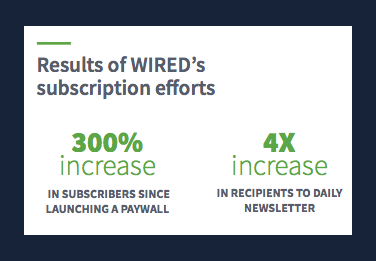
That means that you should probably put email newsletter strategy at the top of your priority list. Need somewhere to start? We’ve put together a list of metrics to understand and questions to ask to get you started.
Email Newsletter Strategy Checklist
What’s already working with your email newsletters?
Look at any newsletters you already run. To understand valuable readers find it, evaluate:
- Open rates (total opens / total addresses the email was delivered to) give you a sense of overall engagement, especially when tracked over time.
- Click-to-open rates (total unique clicks on the email / total unique opens) tell you if readers are clicking on the links you’re sending, which may or may not be the goal of the newsletter.
- Unique open rate (total unique opens / total emails delivered) when compared to general open rate answers: do we have a smaller segment of people opening our newsletter multiple times? Or many people opening it once?
- Unique clicks rate (total unique user clicks / total emails delivered) can help you understand if CTAs are working, if you have them.
- Unsubscribe rates tell you if you’re annoying people, or not delivering on what you said you would.
For a more nuanced analysis, you can segment your existing newsletter audience into groups. Depending on how frequently you send newsletters, you can determine which readers fit into each bucket:
- Frequent readers who open more than one of your newsletters a week (or month)
- Occasional readers who opened a newsletter once in the past three months
- Disappeared readers who no longer open your emails, but haven’t unsubscribed
Beyond looking at the data around these segments, you can send each group a survey on why they do, or don’t, read your newsletter. Hearing direct feedback adds a human element to any data analysis you do. We also recommend clearing out your list of people who no longer read.
How are you growing email newsletter lists?
Another metric you should know? Your current subscriber rate: how many new readers sign up for your newsletter as a percentage of the total list size. This tells you how fast you can expect to grow, and sets a benchmark for any improvements you’ll make.
Newsletter sign ups function as “conversion points” for your audience, one that can be tracked and analyzed. Need to improve those conversion numbers? Here are questions to consider:
- Discoverability: Is your newsletter sign up easy to find?
- Promotion: Could you promote your newsletter sign up in more channels?
- Value proposition: Do people know what value they’ll get when they sign up?
- Relevance: Can you make the information sent to readers more personalized?
The WSJ’s newsletter page allows readers to select exactly which newsletters they want to subscribe to, and includes a preview of each one so that you can check it out before you select “Subscribe.”

A newsletter doesn’t have to be a long-term commitment. According to Didigay, The New York Times‘ Game of Thrones pop-up newsletter had only eight editions… and 80,000 subscribers.
How are you on-boarding your audience?
Yes, you read that correctly. How are you “on-boarding” newsletter readers or subscribers? This term, more commonly found in product development should catch on for content teams. Why?
When the team at WIRED examined their subscriber on-boarding process, they discovered that not all subscribers were being added to their daily newsletter list. The priority for the consumer marketing and product teams then became to fix that issue, add new product features to their newsletters, and improve subscriber on-boarding overall.
“Parse.ly’s data helped us see just how important it was that we get our daily newsletter list fixed, because the more subscribers we can onboard onto our newsletter, the more likely we are to keep in touch with them and retain them with our existing products.” -Indu Chandrasekhar Director of Audience Development, WIRED
Proving newsletters work
Once you’ve done all the work to get readers to sign up, open the email and click through, don’t stop short of the finish line. Understanding the behaviors readers take once on your site can continue to prove the value in a newsletter, or indicate when it’s time for one to get a refresh or retirement.
That’s where UTM parameters come in. UTM parameters are simply tracking codes added to the end of your URLs. When a subscriber clicks a link in your newsletter, you’ll be able to track their engagement
Need some inspiration with how to structure your newsletter campaign tracking? We looked at four newsletters to see how companies structure their tracking parameters.
Axios: Identifying audiences from different newsletters
If your organization sends multiple newsletters, tracking each with a UTM parameter will identify which newsletter is sending traffic to each story. Axios uses the utm_campaign parameter to identify their Axios Login newsletter from their Axios AM newsletter.

| Link: | utm_source: | utm_medium: | utm_campaign: |
| https://www.axios.com/axios-review-samsungs-galaxy-s8-is-beautiful-but-has-incomplete-softwa-2366789451.html | newsletter | newsletter_axioslogin | |
| https://www.axios.com/retail-jobs-declining-after-financial-crisis-2366712352.html | newsletter | newsletter_axiosam |
Codeacademy: Finding the best call-to-action
The Codecademy newsletter uses a utm_content parameter to indicate which call-to-action someone clicked to visit a URL. This method would allow you to quickly compare CTA placements and effectiveness.

| Link: | utm_medium: | utm_campaign: | utm_content: |
| https://www.codecademy.com/learn | Fortnightly-2017-04-19 | newsletter_a | code_something_CTA_main_story |
| https://codecademyready.typeform.com/to/tlzBlo | Fortnightly-2017-04-19 | newsletter_a | share_own_prj_CTA |
Digiday: When do audiences want to read newsletter content?
Digiday uses the utm_content parameter for denoting the newsletter send date. If you include a story in multiple sends of the same newsletter, this method can help identify if certain days or times work better for clicks.
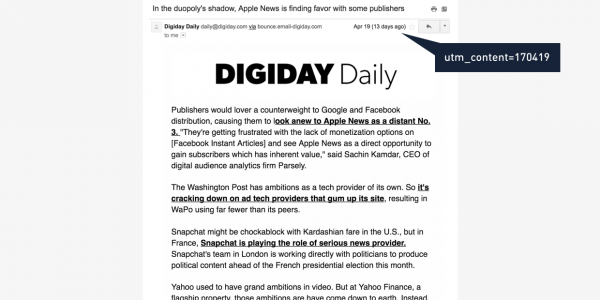
| Link: | utm_source: | utm_medium: | utm_campaign: | utm_content: |
| http://digiday.com/media/duopolys-shadow-apple-news-finding-favor-publishers/ | daily | digidaydis | 170419 |
The Drum: Geo-targeting newsletter readers
The Drum has offices in Glasgow, London, New York, and Singapore. The Drum editors use utm_campaign to show where visitors are coming from to read a story. Seeing how the newsletter audiences in different locations engage with different stories can help The Drum decide how to distribute coverage among their editorial staff.
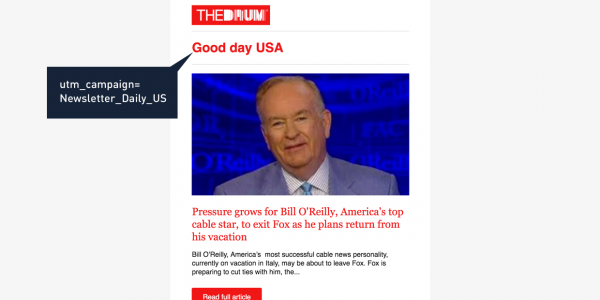
| Link: | utm_source: | utm_medium: | utm_campaign: |
| http://www.thedrum.com/news/2017/04/19/pressure-grows-bill-oreilly-americas-top-cable-star-exit-fox-he-plans-return-his | pardot | Newsletter_Daily_US |
Bonus! For Parse.ly clients: Track your email newsletter subscribers
Since email traffic typically shows up as “direct” traffic, once you start tagging newsletter URLs with UTM parameters, you can see a new layer of metrics in your Parse.ly dashboard.
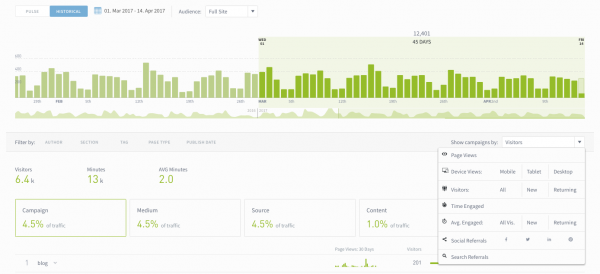
Track your visitors, views, engaged time, and more from your newsletters, all right next to the content analytics data you look at already.
How long do subscribers actively read or watch your content after they click through? Which devices do they use to read your content? What percent of a story’s traffic came from the newsletter? Answer all these questions right in your content analytics system.
Newsletters: A tool to reach your audience goals
Getting readers to sign up for newsletters often isn’t the end goal, you want them to take another step. Whether that’s reading an article, buying a product, or staying loyal to your brand, you should wield your email newsletter sword with power and precision in service of the greater aim.
And if you came to this post just looking for some suggestions of which newsletters you should subscribe to, well I’d suggest the Parse.ly blog, of course. Sign up below!